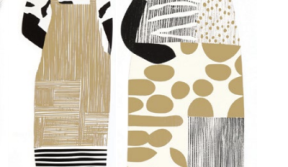Unbelievably, Humayin Kabir, a production manager, denied the workers’ assertions that the exits were locked, explaining, “Maybe the workers could not find their way to the emergency exits as they have claimed that the tenth and eleventh floors were already dark with smoke.”
About 5,000 people work at the Ha-Meem Group factory producing garments for big name brands such as Gap, Abercrombie, JC Penney, and Phillips-Van Heusen (owns Calvin Klein, Tommy Hilfiger, Arrow, Izod, and Bass).
This fire is not the only loss of workers lives in Bangladesh in the past week. The workers across Bangladesh had been protesting a recent insufficient wage increase. Despite the fact that they have consistently demonstrated for higher wages, the new structure still does not enable a worker to put enough food on the table for herself, much less for a family. More than 150 workers were injured and four workers lost their lives during the protest.
A deputy managing director at the factory with the most recent fire, explained that an electrical short circuit was the most likely culprit. Investigations taken up by the government and the Bangladesh Garment and Manufacturers Association (BGMEA) are under way to determine the cause of the fire. As compensation for their lost relatives, the BGMEA and the Ha-Meem Group will each pay the families 100,000 taka ($1,400). However ILRF believes that this is an absolutely unacceptable payment to account for the loss of life and therefore we would expect the suppliers and buyers to reexamine this amount and pay in full the equivalent of the lost wages for the rest of the perished worker's lives.
Fires are not new to Bangladeshi garment workers. In fact, the bodies keep piling up. Between 2006 and 2009, 414 workers died in 213 factory fires. The fire at the Ha-Meem Group factory was not the first one to occur this year either. In February, over 20 workers lost their lives in a Garib & Garib factory fire which was producing for H&M and other brands.
The situation in Bangladesh appears as a scary reflection of early twentieth century America. Young immigrant workers in American cities were subject to similar unjust and unsafe conditions in garment factories. Many were forced to put up with these abuses until March 25, 1911. It was a day of tragedy, but it also marked a huge turning point in factory labor. That Saturday, the Asch Building owned by the Triangle Shirtwaist Company in New York City, burst into flames. Locked doors and inadequate fire safety precautions led to the deaths of 146 (out of 500) workers who were trapped inside the factory behind locked doors. Many jumped to their death rather than face the flames.
Outrage caused by the horror of the fire spread throughout the United States. Across party lines people demanded change. They demanded that workers be allowed to organize and bargain for their rights through a union and that the factories provide a safe and just work environment. Although change did not come at the drop of a hat, eventually the most egregious violations were rid from the U.S. garment industry as a result of the Triangle Shirtwaist fire tragedy.
Today, Bangladeshi workers are fighting for the same rights American garment workers fought for so long ago. Their struggle mirrors our own. They have protested, tried to form unions, demanded wage increases, and even suffered harassment and death at the hands of irresponsible managers and companies. Since they are making clothes for the U.S. market, their deaths should spark the same outrage that raced across America nearly 100 years ago.
Support Bangladeshi garment workers’ rights by letting clothing companies who purchase their products from Bangladesh know that you will not stand for their negligence regarding working conditions any longer. The big brands control the supply chain and only when they are forced to set clear requirements on factory management will workers finally see an improvement on the factory floor.
Not surprisingly, ILRF’s “Working for Scrooge” report released last Friday, December 10, highlights the Bangladesh Garment and Manufacturers Association (BGMEA) as one of the worst violators of workers’ right to associate. To read why, click here.
To read more about the severe and ongoing crackdown on labor rights in Bangladesh, see ILRF’s new report “Enemies of the Nation or Human Rights Defenders: Fighting Poverty Wages in Bangladesh.”


Comments
re: Bangladeshi Ha-Meem Group Garment Factory Goes Up in Smoke a
Wow I am shocked and saddened by this news in Bangladesh. When will the companies such as JC Penney and Abercrombie take their responsibility to the workers to make sure they have a safe job!?!
re: Bangladeshi Ha-Meem Group Garment Factory Goes Up in Smoke a
American consumers must be made aware of labor conditions such as these, as some undoubtedly would become concerned. Enough concern would translate into action. Action would pressure the merchandisers to insist that their suppliers stop creating image problems for their brands. Above all, such activity would be noticed by struggling workers worldwide, and encourage them to continue to press for improvement in their lives. We must make this happen.
re: Bangladeshi Ha-Meem Group Garment Factory Goes Up in Smoke a
WE need job and safe environment in work place. But the way you are talking, I am afraid I am afraid if H&M turned on, we will loose jobsand suffer from hunger. I am more than happy we are working now and have a job in garments factory